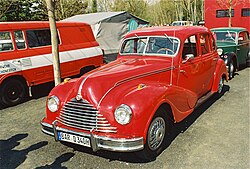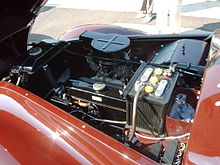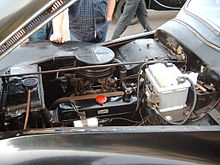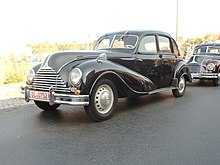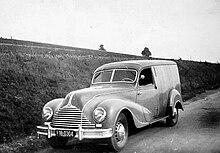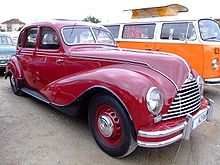EMW 340
| EMW | |
|---|---|
| BMW / EMW 340 | |
| Production period: | 1949-1955 |
| Class : | Middle class |
| Body versions : | Limousine , station wagon , panel van |
| Engines: |
Otto engine : 2.0 liters (40 kW) |
| Length: | 4600 mm |
| Width: | 1765 mm |
| Height: | 1650 mm |
| Wheelbase : | 2870 mm |
| Empty weight : | 1200 kg |
| Previous model | BMW 326 |
The EMW 340 was a passenger car from the Eisenacher Motorenwerk , which was manufactured from 1949 to 1955, since 1951 as a further developed EMW 340-2. It was based on the pre-war model BMW 326 , which was further developed and given a revised front and rear area. In addition to the limousine, there were also small numbers of emergency bucket vans, station wagons, ambulances and delivery vans.
History of the EMW 340
prolog
From July 3, 1945, Eisenach was in the Soviet zone of occupation . With the threat of dismantling, the head of motorcycle production, Albert Seidler, showed Soviet Marshal Zhukov a BMW 321 sedan, and the latter then demanded that five cars be built. With the order number 93 for "ensuring the delivery of the new passenger cars and motorcycles in the vehicle and machine factory Thuringia", production was resumed in November 1945 as a reparation payment for the Soviet Union. 3000 cars of type "321" and motorcycles of type " R 35 " were required . By order of the state president of Thuringia , all operating facilities were expropriated in September 1945. Contradictions from the BMW headquarters in Munich were answered as follows: "[the contradictions] are only to be assessed as robbery claims by the monopoly lords and warmongers of BMW-Munich who are again in the leading position of German imperialism in West Germany today ". On September 15, 1946, the plant was incorporated into the Soviet joint-stock company Awtowelo . The planned economy had begun.
The EMW 340
As early as 1948, the new "BMW 340" was developed in the former BMW plant in Eisenach. Building on the "BMW 326" from 1936, mainly the bonnet, the rear, as well as the dashboard and instruments were changed. At the front, the headlights were integrated into the fenders and the typical BMW kidney grille gave way to a radiator grille consisting of horizontal metal struts . The bonnet no longer opened along the vehicle's longitudinal axis towards the center, but in one piece forwards. The rear was changed in such a way that the trunk , which on the old BMW models could only be reached from the inside by folding down the rear bench seat, was now accessible from the outside through a trunk lid. To do this, the spare wheel previously mounted on the rear had to be stowed under a wooden shelf in the trunk. This compartment also housed some breakdown aids such as the jack and the air pump . Additional tools were included in a removable tool box that was located in the engine compartment. Underneath is a hose and a special key for brake bleeding. After the vehicle had been developed within a very short time, several copies were sent on a 10,000 km test drive . This was staged in an effective advertising manner. After the successful completion of this journey, series production began. A major problem became clear here: many of the old pre-war suppliers were now in West Germany. As a result, many parts now had to be manufactured in-house or other suppliers found. Another problem was the poor quality of the parts delivered. Despite efforts to remedy this deficiency themselves, they had to rely on supplies from the West. Since these did not always come regularly, production sometimes stood still. Attempts were made to supply Western European markets as well. However, there were always quality problems, which is why customers mostly turned to BMW Munich for rework due to ignorance.
For this reason, among other things, BMW in Munich were the BMW cars and motorcycles from East German production a thorn in the side (their own production also started slowly), so that it came to a legal dispute. With the judgment of the Düsseldorf Regional Court on November 17, 1950, confiscations threatened to endanger foreign exchange if Eisenach continued to produce under the BMW name. According to various sources, from July 1, 1952, no BMW, but only EMW emblems were mounted on the vehicles, at least on the western export vehicles. BMW emblems are said to have been fitted to the vehicles that were delivered to the “socialist brother countries” for some time. So BMW became EMW; the white and blue propeller became a red and white company emblem. At around the same time, the plant was incorporated as a state- owned company into the Industrieverband Fahrzeugbau (IFA). In 1953 the plant was renamed VEB Automobilwerk Eisenach . Around 19,000 vehicles were exported together with BMW 321 and EMW 327.
In 1952 the production of an EMW 340-7 station wagon was started in addition to the EMW 327 .
EMW as a trademark ended with the discontinuation of production of the car types "340/2" and "327/3" and the motorcycle "R35 / 3" in 1955.
epilogue

The engineers at the Eisenach factory, experienced in vehicle construction, always tried to improve their vehicles, but failed to implement them for the reasons mentioned above. At the Leipzig autumn fair in 1952, the EMW 340-8 was presented, which should have a different front design, better equipment and a 60 hp engine. "The EMW 340-8 will replace the 340 " was the motto in 1952. However, the car no longer went into series production. In 1951 the types BMW 342 and 343 were officially presented. The former was based on a pre-war design with the BMW 332 . Here, too, there were a few prototypes, all of which presumably no longer exist.
The IFA F9 , which was developed in Zwickau and equipped with a two-stroke engine , was then manufactured in Eisenach, followed by the Wartburg 311 developed from this . The departure from the mid-range car with a four-stroke engine was not without a murmur from the Eisenach plant. It was a government directive that went back to RGW resolutions, according to which the GDR had to concentrate on the production of smaller two-stroke cars. Motorcycle production was also discontinued, as the AWO 425 with four-stroke engine had been produced in Suhl, Thuringia, and MZ two- stroke motorcycles in Zschopau, Saxony .
technology
engine
The engine is an in-line six-cylinder with a displacement of 1971 cm³. This is equipped with two BVF (Berlin carburetor factory) IFA (TYPE F323-1) or Solex carburetors (TYPE 32PB I with acceleration pump ). These are downdraft carburetors . With these, the engine delivers 55 or later 57 hp. In the GDR era, retrofitting to only one BVF carburetor was recommended and partially implemented. Long after production stopped, the EMW motor was used for various research purposes. In 1958, tests were carried out on a constant pressure carburetor , a SU oblique flow carburetor type H 6, as well as attempts to increase performance by using a modified cylinder head.
The oil filter is also interesting on this engine . From today's point of view, the design of the disc filter , which is unusual , is driven by the clutch pedal. There are metal sheets in the filter on which the dirt sticks. In the middle of the filter, knives are attached to an axis that run along the gaps between the metal sheets and scrape off the dirt, which then sinks down. Each time the clutch pedal is actuated, the axis and thus the blades are moved a little further via a linkage and a ratchet mechanism . A drain plug on the underside of the filter must be unscrewed and the dirt drained off at regular intervals. A mechanical diaphragm pump is used to deliver the fuel.
transmission
In the EMW 340, the same gearbox is used for the most part as in the BMW 326 . This has four gears, the first and second of which are equipped with a freewheel. In contrast to the gearbox of the BMW 326, it can no longer be operated via a gear stick, but via a steering column shift. For this purpose, a rod and a cable or wire were interposed. However, the wire often broke, which is why some vehicles were converted back to stick shifting. The drive force is transmitted to the rear axle and thus to the rear wheels via a cardan shaft .
Cooling and heating
The engine is cooled by water circulation, as is the case with most of today's cars, but here too with some differences. In order to ensure that the cooling water is heated up quickly and to prevent the engine from overheating later, the driver has to lend a hand himself. For this purpose there is a blind in front of the radiator , which is opened or closed via a linkage from the dashboard . This allows more or less air to flow through the radiator, increasing or decreasing the operating temperature of the engine. The driver should keep the cooling water temperature at 80 degrees Celsius if possible.
If no antifreeze was added, the cooling water had to be drained off during the winter months when there was frost. If you wanted to drive the car, warm water first had to be poured into the radiator with the drain cock open until the engine was warm. Even if the vehicle has not been used for a long time (if it has not been used for several days), the engine should first be cranked a few times in order to distribute the engine oil in the engine again.
The BMW 340 did not yet have a heater. A heater was not installed until the vehicle was revised and the type designation was changed to 340-2 . Here, too, the ease of use was not as advanced as we know it today: in order to switch on the heating, a shut-off valve in the engine compartment first had to be opened. It was then regulated via the switchable electric fan blower and a regulating flap in the passenger footwell.
Axles, suspension and steering
At the front, the axle consists of a cross member into which a leaf spring is installed. The two wheels are mounted on it via a swivel joint , so it also takes over the lower wheel guidance . The lever of the lever shock absorber serves as the upper wishbone . The lever shock absorbers are mounted on top of the cross member. The movement is transmitted from the shock absorber arm to a shaft in the shock absorber on which a finger is mounted. This moves a piston in an oil-filled chamber in the damper. As it moves, it pushes the oil through channels to the other side of the chamber, the flow rate being limited by adjustable valves. Shock absorption is achieved through the pressure generated.
The rigid rear axle consists of two halves pressed and welded together. It also houses the differential and wheel drive shafts. In the middle it is guided by a guide triangle. Two torsion bars installed in the longitudinal direction of the vehicle serve as springs. These are each guided through a shock absorber screwed to the vehicle floor. These are also lever shock absorbers. Its lever arm also serves as a support lever (link) for the rear axle and thus also takes over the wheel guidance. A short connecting rod is interposed to compensate for movement . All important joints on the chassis had to be supplied with oil by means of a central lubrication that was operated every 50 kilometers .
construction
The body is a self-supporting all-steel body with some wooden parts that are mainly used to attach the interior panels.
Only the roof cut-out is closed by a clad wooden strut structure, which is constructed like this (from top to bottom):
- Synthetic leather covering
- wire mesh
- Wooden frame
- Headliner
The front and rear windows are each divided in the middle. The windshield was originally intended to be fitted with opening mechanisms, which, however, according to official documents, was not adopted into series production. Small hinged windows are still installed after the two rear doors.
Interior
The EMW 340 had two single seats at the front and a continuous bench with a fold-out armrest at the rear. The hinged windshield was adopted from the 326. This was divided in the middle so that both sides could be tilted independently of one another using an adjusting screw. The resulting gap at the base of the pane enabled improved interior ventilation. The further development EMW 340/2 also has a continuous bench at the front, the rear armrest is omitted. Due to the design, the gear shift was designed as a steering wheel shift from this point in time, which was considered very modern in automotive engineering at that time. The front window could no longer be opened.
In addition, the vehicle fleet of the state-owned taxi companies consisted predominantly of the EMW 340 type until the end of the 1950s - in contrast to the few licensed private taxi companies that often still drove with pre-war models (Opel).
In export models, a folding roof was often installed instead of the roof cutout closed with artificial leather. A radio was supplied as a special request.
A mechanical clock was mounted in the glove compartment lid, which ran for several days after being wound up once.
Model variants

BMW 340/1 and 340-S
The BMW 340/1 was a one-off production, designed by the designer Hans Fleischer as a prototype of a roadster that was presented as a new sports vehicle at the Leipzig spring fair in 1949. The 340/1 was equipped with the serial engine of the 340, a six-cylinder with 55 hp. Instead of the steering wheel shift of the production version, it received a stick shift. The roof could be lowered behind the driver's seats.
In 1950 the 340-S was presented as a sports variant of the 340/1. This was used as a racing vehicle with a 90 hp engine at three events, first on the Dessau autobahn race track , then on the Sachsenring and at the Leipzig city park race .
The roadster and sports car concept was no longer pursued and discontinued after a prototype was built. The 340-S was wrecked while filming Rivals at the Wheel in 1956.
340/3 and 340/4
The 340/3 was a panel delivery van that was manufactured from 1950 to 1951 on the basis of the 340 at VEB Karosseriewerke Halle . The box structure was partly made of wood. The 340/4 was designed as a medical vehicle.
gallery
literature
- The BMW 340. In: Motor vehicle technology 10/1951, pp. 240–242.
- Eberhard Kittler: GDR automobile classics. Vol. 1. Motorbuch, Stuttgart 2002, ISBN 3-613-02256-7 .
- Michael Dünnebier, Eberhard Kittler: German cars. All passenger cars and commercial vehicles of the GDR. Motorbuch, Stuttgart 2006, ISBN 3-613-02652-X .
- Horst Ihling: Car racing in the GDR. Wartburg, EMW & Co. Delius Klasing, Bielefeld 2006, ISBN 3-7688-5788-3 .
Web links
- Eisenach Automobile Museum
- Jörg Kaiser's page: EMW / BMW 340 and EMW / BMW R35
- Harald Spiegel's EMW-340 page
Individual evidence
- ^ BMW Eisenach became public property. In: Motor vehicle technology 6/1952, p. 193.
- ↑ 10 years of motor vehicle exports in the German Democratic Republic. In: Motor Vehicle Technology 2/1958, pp. 41–43.
- ↑ What was new? In: Motor vehicle technology 11/1952, p. 329.
- ↑ What was new? In: Automobiltechnik 11/1952, p. 330.
- ^ Report on prototypes from Eisenach vehicle production after the Second World War, including the BMW 342 before and after the ban on the use of the BMW kidney and logo , accessed on February 20, 2010
- ↑ EMW 340 with only one BVF carburetor. In: Motor Vehicle Technology 10/1957, pp. 373-375.
- ↑ EMW 340 with a SU carburetor. In: Motor Vehicle Technology 7/1958, pp. 244–248 and 8/1958, pp. 289–293.
- ↑ EMW 340 with retracted combustion chamber (squeezing head). In: Motor Vehicle Technology 11/1958, pp. 404-407; 8/1959, pp. 308-310; 2/1960, pp. 42-45 and 6/1961, pp. 234-239.
- ^ GDR vehicles from AWO to Wartburg, Garant-Verlag, 2012, ISBN 978-3-86766-378-6 , page 49
- ↑ a b Horst Ihling : Auto racing in the GDR: 90 years of racing cars and motor racing. Delius Klasing Verlag, Bielefeld, October 2006, ISBN 978-3-7688-5788-8 , page 59ff.
- ↑ Horst Ihling : Auto racing in the GDR: 90 years of racing cars and motor racing. Delius Klasing Verlag, Bielefeld, October 2006, ISBN 978-3-7688-5788-8 , pages 105 and 142.
- ^ GDR vehicles from AWO to Wartburg, Garant-Verlag, 2012, ISBN 978-3-86766-378-6 , page 52
